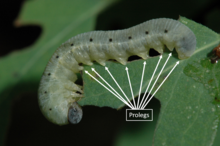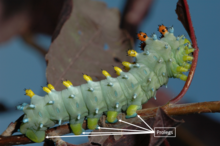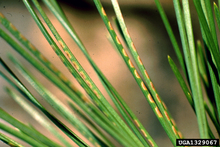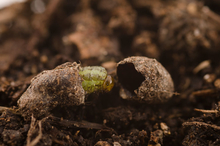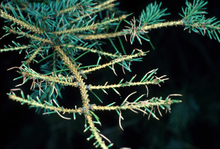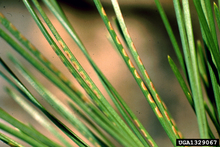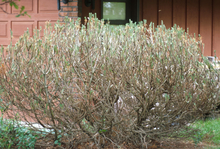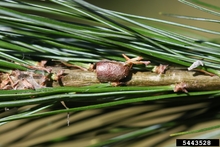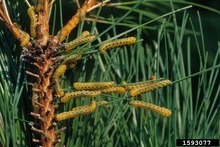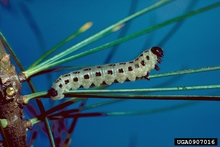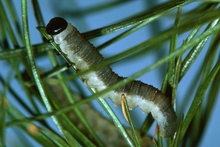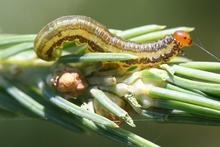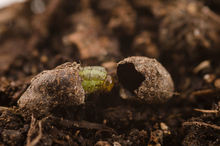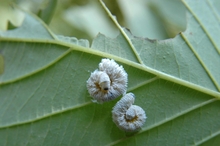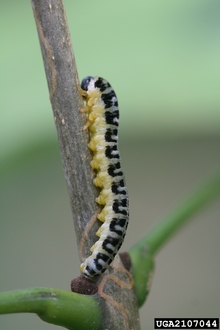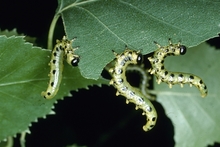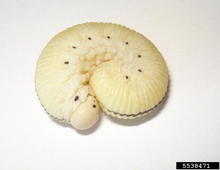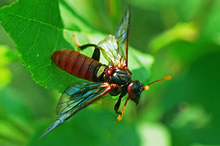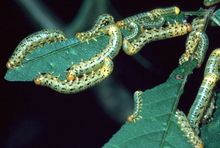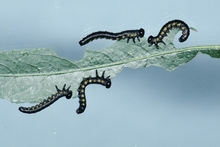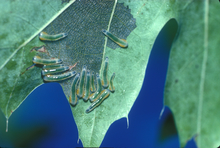Quick facts
- Sawflies are common in the landscape, feeding on many trees and shrubs.
- Sawfly larvae resembles butterfly and moth caterpillars so accurate identification is important.
- Sawfly damage can affect the appearance of trees or shrubs but usually does not affect plant health.
- There are several nonchemical and pesticide options for protecting trees and shrubs from sawflies
How to identify sawflies
Sawflies are related to wasps and bees. Their name comes from the saw-like ovipositor (egg-laying structure) of adult females. Adult sawflies are small, stout-bodied, non-stinging wasp-like insects, although they are seldom noticed in the landscape.
Differences between sawfly larvae and butterfly and moth caterpillars
Sawfly larvae are more commonly seen than adult sawflies. They look similar to butterfly and moth caterpillars. They differ from each other in the number of prolegs—the fleshy, leg-like projections on the abdomen.
- Caterpillars have two to five pairs of prolegs on the abdomen.
- Sawflies have six pairs of prolegs or more.
- The prolegs on slug sawflies are small and may be overlooked.
- Sawfly larvae are smooth with little or no hair and are no more than one inch long when fully grown.
- Moth and butterfly caterpillars can be smooth, hairy or spiny, and vary in size when mature. They may often be larger than one inch long.
Biology of sawflies
Most sawflies in Minnesota have one generation per year (that is it takes one year to go completely through their life cycle once), although some go through two generations.
Adult females use their saw-like ovipositors to cut slits into needles, leaves, or tender new shoots to lay eggs.
Eggs hatch into larvae that feed on foliage of their host plants for about four to six weeks.
- It is common for most sawflies to feed gregariously, in non-social groups.
- When in such a group, if they are threatened, they can simultaneously raise and arch their bodies as a defensive tactic (presumably to scare away would be predators).
Many sawflies overwinter in the soil as pre-pupae (the stage between a mature larva and pupa) or pupae in cocoons; some species also overwinter as eggs or larvae. Adults typically emerge in the spring or early summer.
When sawflies are first active in the spring depends on:
- Where in Minnesota they are found (generally the further north in the state, the later they will first become active).
- Whether spring is early, late, or normal.
Damage caused by sawflies
Sawfly feeding can vary from slight to severe. The larvae typically feed in groups, and it is not uncommon for feeding to occur on just a few branches, although a severe infestation can cover an entire plant.
Conifer-feeding sawflies:
- Some species emerge very early in the spring before new growth on trees has occurred and eat older needles from previous years.
- Sawflies emerging later in spring feed on new growth.
- A few species eat both new and old foliage, and these species can completely strip conifer trees of their needles in one season.
Deciduous plant-feeding sawflies
- Larvae often feed along the edges of the leaves and can chew the leaf blade down to the midrib.
- Slug sawflies feed by chewing leaf tissue on one surface of the leaf between the veins, a type of feeding known as windowpane feeding.
- Damaged leaves at first are whitish; eventually these injured areas turn brown.
Healthy, mature deciduous plants can typically tolerate sawfly feeding in one season.
- Even when it is severe, as deciduous plants can regrow leaves.
- However, recently transplanted trees and shrubs and plants that have been severely defoliated in several consecutive years are more susceptible to injury.
Sawflies attacking conifers feed on the surface of needles at first, leaving needles discolored, distorted, and straw-like.
- As the larvae grow larger, they consume entire needles.
- With the exception of tamarack, conifers do not regrow new needles once they are consumed.
Even if sawfly defoliation does not impact plant health, defoliation may negatively affect the appearance of trees or shrubs.
How to protect your plants from sawflies
Management for sawflies depends on many factors:
- Time of year
- Health of the plant
- Conifer or deciduous tree or shrub
- Number and size of sawfly larvae
Monitor plants you suspect may be attacked by sawflies. Early detection allows for more effective treatment and reduced damage to host plants.
- Use the life cycle information to predict when larvae of a particular species will be first active.
- The first appearance of larvae can vary depending on the arrival of spring weather and the part of Minnesota where the trees or shrubs are located.
- Start looking for larvae before you expect them to be first active.
- Keep trees and shrubs healthy; a healthy plant does not suffer as much damage from sawflies.
- Select plants that are hardy for your area and plant them in sites that encourage growth.
- Maintain plant health through proper cultural care, including watering and fertilizing.
- For more information, see University of Minnesota Extension pages on Trees and Shrubs.
- Small numbers of sawflies can be physically removed from plants and killed by putting them into a pail of soapy water.
- You may also crush them on the plants or use a high pressure water spray to knock them off.
Treat sawfly larvae when they are young and half their full-grown size or less when pesticides are more effective. If larvae are fully grown, the damage is done and treatment is not effective.
Most sawflies feed in groups, and it is possible to spot treat them instead of treating the entire plant. This helps reduce the amount of pesticide used.
Low impact pesticides
Insecticidal soap and horticultural oil are effective when managing small numbers of young sawfly larvae.
- These products have minimal impact on natural enemies.
- Repeat applications might be needed as the product only affects sawflies it directly contacts.
Azadirachtin and spinosad are effective for one or two weeks so sawflies that feed on treated foliage are still affected.
Bacillus thuringiensis var. kurstaki (Btk) is a common low impact insecticide used against moth and butterfly caterpillars. It is specific to caterpillars and does not kill sawfly larvae.
Contact residual insecticides
Examples of contact residual pesticides that are effective include permethrin, bifenthrin, lambda cyhalothrin, and carbaryl are most effective against young sawfly larvae. One application is usually sufficient.
Systemic insecticides
Systemic insecticides are pesticides that are transported by the plant through tissues that carry food and water to the leaves and needles. When sawflies feed on the needles and leaves, they receive a toxic dose. Common examples are imidacloprid and dinotefuran.
CAUTION: Be careful when applying systemic insecticides to hardwood trees and shrubs that are attractive to bees. This includes linden, crab apple and sugar maple, as well as juneberry (serviceberry), pagoda dogwood, nannyberry viburnum and many other shrubs. This does not include evergreen trees and shrubs. (For a list of bee attractive trees and shrubs, see Native trees and shrubs for pollinators).
Apply systemic insecticides to trees and shrubs only after flowering has already occurred to reduce pesticide exposure to bees. If sawflies are active when trees and shrubs are flowering, use an alternative method of treating them.
Do not apply systemic soil drench pesticides when flowering plants are next to trees or shrubs.
Professional services
Commercial tree care companies have experience in managing sawflies and in applying pesticides. When treating trees is not practical, use a licensed pesticide applicator working for a professional company.
CAUTION: Mention of a pesticide or use of a pesticide label is for educational purposes only. Always follow the pesticide label directions attached to the pesticide container you are using. Remember, the label is the law.
Sawflies on coniferous trees and shrubs
(Neodiprion sertifer)
Appearance:
- Larvae are 18 - 25 mm (3/4 - 1") when fully grown and gray-green with black heads and legs.
- They have a light colored stripe running down its back, two light colored stripes and one dark stripe on each side.
Life cycle: There is one generation per year.
- Live through the winter as eggs in last season's needles.
- Larvae begin feeding around mid-May and continue through June.
- After feeding, larvae transform into pupae in the soil or on trees.
- Adults begin appearing in early September through late fall.
- Adults lay eggs in the current season's needles near the ends of branches.
Hosts: Mugo, Scots, red and jack pines are preferred; eastern white, Austrian and Ponderosa pines may also be fed on, especially if they are growing near a preferred host.
Damage: Larvae eat all of last year's needles on a single branch before moving to another branch. They will leave a tree for a new host once all of last year’s needles on that tree have been eaten.
- Larvae only feed on old needles, but may also feed on the bark of new shoots which can cause twig death.
- Their damage does not kill plants since these sawflies do not eat new needles.
- Repeated defoliation can slow growth and negatively affect their appearance.
Management: Look for sawfly larvae in the spring and if necessary use a pesticide to treat them.
- Spot treat when possible as European pine sawflies commonly feed in groups.
- In the fall, apply imidacloprid or dinotefuron to the soil to control larvae for the following spring.
(Diprion similis)
Appearance:
- Larvae have black heads, a double black stripe running the length of the top of its body with many yellow, white and black spots.
- They are 20 - 25 mm (3/4 - 1") when full grown.
Life cycle:
- Spend the winter as prepupae in cocoons on twigs.
- Adults emerge in early May and lay eggs that hatch in late May.
- First generation larvae begin feeding from late May into early June.
- The larvae from a second generation feed from late July through early September.
Hosts: White pine is preferred, but they will also feed on Scots, jack, and red pines.
Damage: First generation larvae eat last year's needles. Second generation larvae feed on both new and old needles.
- Older larvae can eat bark if the needles are absent.
- Defoliation is most severe in the upper half of trees, but entire trees can be defoliated if populations are high.
Management: Look for introduced pine sawflies in early spring and again in mid-summer. Use appropriate pesticide if it is necessary to treat larvae.
(Neodiprion lecontei)
Appearance:
- Larvae have reddish brown heads, yellow bodies with six rows of irregular black spots.
- They are 20-30 mm (3/4 - 1") long when fully grown.
Life cycle:
- Spend the winter as pupae in the soil.
- Adults emerge in June and lay eggs that hatch in three to five weeks.
- Larvae feed between mid-June and late July and then drop to the ground.
- There they transform into pupae in the soil where they remain for the winter.
Hosts: Many species of pines; red and jack pines less than 15 feet tall are preferred.
Damage:
- One of the most damaging sawflies on pines, they feed on either new or old needles.
- They can completely defoliate a tree starting from the top and moving down.
- Young trees are preferred hosts.
Management: Look for redheaded pine sawflies from late spring to early summer. Use an appropriate insecticide if it is necessary to treat larvae.
(Neodiprion pinetum)
Appearance:
- Larvae are pale yellow with black heads and have four rows of black spots from the head to the end of the abdomen.
- They are about 25 mm (1") when fully grown.
Life cycle:
- Adult females lay eggs in needles in the spring.
- Larvae feed from late June to early August.
- After feeding, larvae drop to the ground and spin cocoons where they spend the winter as prepupae (the stage between a mature larva and pupa).
- There is usually one generation per year.
Hosts: Eastern white pine is preferred, but they can also feed on other pines, such as red pine.
Damage:
- White pine sawfly larvae feed on both new and old needles and attack trees of all sizes.
- They defoliate one branch before moving to another.
- Larvae can completely defoliate trees.
Management: Look for white pine sawflies in early summer. Use a pesticide if it is necessary to treat larvae.
(Pristiphora erichsonii)
Appearance:
- Larvae have black heads, gray-green bodies with white undersides.
- They are 16 mm (1/2") long when fully grown.
Life cycle:
- They spend the winter in the soil as prepupae (the stage between a mature larva and a pupa)
- Adults emerge in the spring and lay eggs in elongating shoots on branches.
- Larvae hatch in early June and feed on tufts of needles of older twigs.
- Larvae feed for about three weeks and can feed into September.
- All larval stages can be found at the same time on trees, due to an extended period of egg-laying.
- There is one generation of larch sawfly per year.
Hosts: Tamarack and other larch species
Damage:
- Adult egg laying can cause new shoots to curl as they grow.
- 100% defoliation occurs rarely because larvae don't feed on the new elongating shoots.
- Tamarack and other larch trees produce new foliage to replace damaged tissues.
- Repeated heavy feeding results in thin foliage and reduced growth.
Management: Look for larch sawflies in early summer. Use a pesticide if it is necessary to treat larvae.
(Pikonema alaskensis)
Appearance:
- Larvae have yellow or reddish brown heads and olive-green bodies with six gray-green stripes.
- They are 18 mm (3/4") in length when fully grown.
Life cycle:
- They spend the winter as prepupae (the stage between a mature larva and a pupa) in the soil.
- Adult females deposit eggs in new needles and larvae begin feeding in late May to mid-June.
- Larvae feed for four to six weeks and complete development by late July.
- There is one generation per year.
Hosts: White spruce is preferred; all spruce species native to North America and Norway spruce can be potential hosts.
Damage:
- Larvae prefer new needles, but will eat last year’s needles when new foliage is scarce.
- Defoliation for three or four years in a row can kill a tree.
Management:
- Look for yellowheaded spruce sawflies in spring.
- Use a pesticide if it is necessary to treat larvae.
- A soil application of imidacloprid or dinotefuron in the fall will control larvae the following spring if persistent infestations have been occurring.
Sawflies on deciduous trees and shrubs
(Amauronematus azalea and Nematus lipvskyi)
Appearance:
- Larvae are green, smooth skinned and very closely match the color of the azalea leaves.
- Fully grown larvae are 18 - 25 mm (¾ - 1 inch) in length.
Life cycle:
- They spend the winter as pre-pupae (the stage between a mature larva and a pupa) in the soil and emerge just as the new leaves appear.
- Adults lay eggs on the edges of leaves and larvae hatch in May. Larvae will feed until June.
- There is only one generation per year.
Hosts: Ornamental hybrids of azalea especially Rhododendron mollis and R. occidentalis.
Damage:
- Larvae feed on foliage at the tips of twigs and branches.
- They feed on all the foliage along the edge to the midrib of the leaf.
- It is possible for entire plants to be defoliated.
Azalea sawfly defoliation
Management:
- Look for azalea sawflies in early spring.
- Use a pesticide if it is necessary to treat larvae.
- Azaleas may be blooming when sawflies are found so take precautions to protect pollinators.
- Use low impact management methods when possible.
(Tethida barda)
Appearance:
- Larvae are whitish yellow with black heads and legs.
- They are about 18 mm (3/4") when fully grown.
Life cycle:
- They spend the winter as prepupae (the stage between a mature larva and a pupa) in the soil and transform into pupae in early spring.
- Adults appear in May and lay eggs in the leaves.
- Larvae feed from early May through June. There is one generation per year.
Hosts: Ash
Damage: Young larvae chew holes in the leaves and older larvae consume the entire leaves except for the largest veins.
Management: Look for blackheaded ash sawflies in early spring. Use a pesticide if it is necessary to treat larvae.
(Macremphytus tarsatus)
Appearance: Dogwood sawflies vary in appearance.
- The second life stage produces a white waxy, fuzzy material that covers their bodies.
- They eventually lose this white material and later stages are greenish yellow with black spots.
- Larvae are about 25 mm (1 inch) long when fully grown.
Life cycle:
- They spend the winter as larvae in soft or rotten wood and transform into pupae in the spring.
- Adults emerge from late May through July and lay eggs on the leaves.
- Eggs hatch and larvae feed on foliage between July and September.
- There is one generation per year.
Hosts: Dogwood, especially gray and redosier.
Damage:
- Larvae begin feeding as a group on leaves.
- Young larvae chew between the veins and older larvae feed along the edge of leaves and chew leaves down to the midrib. High numbers can cause defoliation.
- Larvae can occasionally damage wood in structures such as decks, landscape timbers, and even homes.
Management: Look for dogwood sawflies starting in mid-summer. Use a pesticide if it is necessary to treat larvae.
(Croesus latitarsus)
Appearance:
- Larvae have shiny black heads and distinct black spots on their bodies. New larvae are dark gray.
- As larvae grow they become greenish-gray, and are yellowish-green when fully grown.
- Larvae are 24 mm (1") long when fully grown.
Life cycle:
- The larvae spend the winter as prepupae (the stage between a mature larva and a pupa) in the soil.
- Adults lay eggs on foliage in the spring.
- First generation larvae feed from May to early July. A second, overlapping generation will feed through September.
Hosts: Native and non-native birch, especially gray birch
Damage: Young larvae consume all of the leaf except for the mid-vein and main lateral veins. Older larvae consume entire leaves.
Management: Look for dusky birch sawfly during spring and again in mid-summer. Use a pesticide if it is necessary to treat larvae.
(Cimbex americana)
Appearance: This is the largest species of sawfly found in North America
- Full-grown larvae are 40 - 50 mm (1.5 - 2.0 inches) in length.
- The body is light yellow to light green in color (sometimes they are pink) with a black stripe along its back and black dots on the base of each segment.
- When resting, the larva will often coil up to protect itself.
Life cycle:
- Adults appear in early May to mid-June.
- After mating, females cut slits in the lower surfaces of leaves where they deposit eggs.
- Larvae hatch in 7 – 10 days and feed on foliage until late summer or early autumn.
- Mature larvae drop to the ground and search for pupation sites at the base of the host tree, where they spin cocoons and spend the winter as prepupae (the stage between a mature larva and a pupa).
- Pupae do not appear until the following spring, although some prepupae pass a second winter before transforming into pupae.
- There is only one generation per year.
Hosts: Elm, willow, birch, maple, cottonwood, aspen and other poplars.
Damage:
- Larvae cause defoliation of elms and willows, especially in urban settings.
- Adult elm sawflies feed on tree sap and sometimes resulting in girdling and death of the limbs.
Management: Management of elm sawflies is rarely needed.
(Pristiphora geniculata)
Appearance:
- Larvae are pale green-yellow with rows of black square spots with either black or orange heads.
- They are 16 - 20 mm (1/2 - 3/4") long when full grown.
Life cycle:
- Adults spend the winter in the soil as pupae and begin to emerge in mid-May.
- Adults emerge over a six-week period and larvae can be seen up to July.
- Most of these larvae transform into pupae in the soil and remain there until spring.
- A few larvae emerge and produce a second generation from late July to September.
Hosts: Mountain-ash
Damage:
- Larvae feed in groups when young and singly when they get older.
- They feed on the edge of leaves, often eating them down to the midribs.
- High numbers can cause significant defoliation.
Management: Look for mountain ash sawflies in spring and again in mid-summer. Use a pesticide if it is necessary to treat larvae.
(Nematus ventralis)
Appearance:
- Larvae are black or greenish black with large yellow spots along their sides with black heads.
- Larvae are 18 mm (3/4") when full grown.
Life cycle:
- They spend the winter as prepupae (the stage between a mature larva and a pupa) in the soil.
- Larvae first appear in May and feed through June.
- The larvae transform into pupae in the soil and either emerge as adults to lay eggs in July or stay in the soil until the following spring.
- A second generation occurs in July, feeding until the end of the summer when the larvae pupate in the soil for the winter.
Hosts: Willows, cottonwood, aspen and other poplars
Damage:
- Larvae initially eat small holes in the leaves.
- As they grow larger, they consume nearly the entire leaf leaving only the midrib.
- Occasionally defoliation can be severe.
Management: Look for willow sawflies in spring and again in mid-summer. Use a pesticide if it is necessary to treat larvae.
Slug sawflies on deciduous trees and shrubs
(Caliroa cerasi)
Appearance:
- Larvae are slug-like in shape and are shiny olive green in color.
- They are 12 mm (1/2") when fully grown.
Life cycle:
- They spend the winter as prepupae (the stage between a mature larva and a pupa) in the soil.
- Adults emerge and lay eggs on leaves in late June and July.
- Larvae hatch and feed for about one month, then drop to the soil to pupate.
- A second generation of larvae begin to feed again in early August.
Hosts: Plum, cherry, cotoneaster, pear, mountain-ash and hawthorn.
Damage:
- They feed on the upper surface of leaves consuming the tissue between the veins, a type of damage known as windowpane feeding.
- This gives a lacy appearance at first; eventually damaged areas turn brown.
- If feeding is extensive, leaves may shrivel.
Management:
- Look for pear sawflies during mid and late summer.
- Use a pesticide if it is necessary to treat larvae.
- Many of the host trees of pear sawflies may be blooming when sawflies are found.
- Take precautions to protect pollinators; use low impact management methods when possible.
(Endelomyia aethiops)
Appearance:
- Larvae are light green with orange brown heads and are about 13 mm (1/2 ") when fully grown.
- Larvae have a tapered shape that gives them a vague resemblance to a true slug.
Life cycle:
- They spend the winter as prepupae (the stage between a mature larva and a pupa) in the soil.
- Adults emerge in early spring to lay eggs and larvae are first present in mid to late May.
- Full-grown larvae drop from plants and burrow into the soil by the end of June.
- They remain dormant underground until next spring.
- Roseslugs have one generation per year.
Hosts: All wild and cultivated roses
Damage:
- Larvae feed on the upper side of rose leaves between the veins, a type of damage known as windowpane feeding.
- Damaged areas are whitish at first but eventually turn brown. Damage can potentially be severe.
Management:
- Look for roseslugs starting in early spring.
- Use a pesticide if it is necessary to treat larvae.
- Roses may be blooming when sawflies are found.
- Take precautions to protect pollinators; use low impact management methods when possible.
(Caliroa quercuscoccineae)
Appearance:
- Larvae superficially resemble true slugs; their body is largest just behind the head and tapers off toward the posterior.
- Larvae are dark to light green and appear shiny and grow to approximately 13mm (1/2-inch).
Life cycle:
- They spend the winter as pupae two to three inches below the soil surface.
- Adults emerge from the ground in May and June.
- Females insert eggs into leaves of host plants that hatch after one to two weeks.
- Larvae feed on foliage for about four weeks. When fully grown they drop to the ground, burrow into the soil and transform into pupae.
- There is a second generation in late July or August.
- Larvae are present on the trees throughout the summer but signs of feeding become clear in late summer.
Hosts: Northern red oak, northern pin oak, pin oak, swamp white oak, white oak and bur oak
Damage:
- Larvae damage plants by windowpane feeding on the lower surface of the leaves between the veins.
- The upper surface of the leaf remains but eventually dries and turns brown; there is only minor damage.
Management: Look for scarlet oak sawfly in spring and again in mid-summer. Use a pesticide if it is necessary to treat larvae.
Sawflies on herbaceous plants
(Pristophora aquiligae)
Appearance:
- Larvae are green, lacking stripes or spots on their bodies and have greenish heads.
- Larvae grow as large as 19 mm (3/4”) in length when fully grown.
Life cycle:
- They spend the winter as pupae in the soil.
- Adults emerge in the spring and lay eggs on the foliage.
- Larvae feed from May to June.
- They drop to the soil to transform into pupae where they remain until the following spring.
- There is only one generation a year.
Hosts: Columbine
Damage:
- Larvae feed on the edges of leaves, chewing down to the midribs.
- They blend in with the green of the leaves and can be difficult to see.
- Damage can potentially be severe.
Management:
- Look for columbine sawflies starting in early spring.
- Use a pesticide if it is necessary to treat larvae.
- Columbine may be blooming when sawflies are found.
- Take precautions to protect pollinators; use low impact management methods when possible.
Reviewed in 2020


